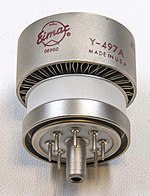




A beam tetrode, sometimes called a beam power tube, is a type of vacuum tube or thermionic valve that has two grids and forms the electron stream from the cathode into multiple partially collimated beams to produce a low potential space charge region between the anode and screen grid to return anode secondary emission electrons to the anode when the anode potential is less than that of the screen grid.[1][2] Beam tetrodes are usually used for power amplification, from audio frequency to radio frequency. The beam tetrode produces greater output power than a triode or pentode with the same anode supply voltage.[3] The first beam tetrode marketed was the Marconi N40, introduced in 1935.[4][5] Beam tetrodes manufactured and used in the 21st century include the 4CX250B, KT66 and variants of the 6L6.
- ^ Donovan P. Geppert, (1951) Basic Electron Tubes, New York: McGraw-Hill, pp. 164 - 179. Retrieved 10 June 2021
- ^ Winfield G. Wagener, (May 1948) "500-Mc. Transmitting Tetrode Design Considerations", Proceedings of the I.R.E., pp. 612, 617. Retrieved 10 June 2021
- ^ Norman H. Crowhurst, (1959) basic audio vol. 2, New York: John F. Rider Publisher Inc., pp. 2-74 - 2-76. Retrieved 7 Oct. 2021
- ^ Editors, (Feb. 1935) "New Output Tetrode", Electronics, vol. 8 no.2, p. 65. Retrieved 10 June 2021
- ^ K. R. Thrower, (2009) British Radio Valves The Classic Years: 1926-1946, Reading, UK: Speedwell, pp. 125 - 126